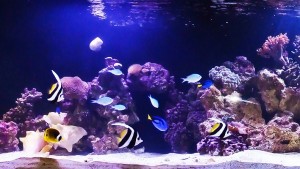As many marine aquarium hobbyists have discovered, adding “just one more fish” to an already-established community can, on occasion, be surprisingly problematic. In some instances, every new specimen that’s added lives only a short time, either succumbing to some unknown malady or finding some little gap in the cover to jump through and ending up as “fish jerky” on the floor.
When this situation arises, the natural inclination is to blame the source of the fish—the dealer—for not giving it proper care to begin with, or we attribute the anomalous death to cyanide poisoning or some other mysterious factor beyond our control. We assume the root of the problem can’t be in our own system because if it were, then at least some of the established fish would be showing signs of illness or distress as well.
So, we keep buying and replacing specimens, ever in pursuit of that one exceptional dealer who doesn’t sell “bad livestock.” However, more often than we’d like to admit, the root of this dilemma is actually right there under our noses—in our own systems—and it’s incumbent upon us to identify the problem and make necessary corrections.
Before blaming your dealer for selling bad fish, consider the following possibilities:
One more fish is one too many
The tank could already be maxed out with respect to bioload, so adding one more specimen tips the biofilter out of balance, resulting in an ammonia spike that claims the stressed-out newcomer first.
Pecking order violation
Any established community of fish will have a pecking order in place to at least some degree. Remember, order of introduction matters! If the new fish on the block is more peaceful by nature than one or more of the established specimens, the newcomer may be targeted for attacks. Then, the stress of the ceaseless conflict can make the newcomer ill or cause it to jump in an effort to escape its tormentors.
Parameter drift
If an important water parameter, such as pH, specific gravity, temperature, or the nitrate level, is allowed to drift out of the desired range over time, the resident fish population may be able to acclimate to the gradual change with no obvious signs of ill health. However, the adjustment to suboptimal water conditions may prove to be too much for a new fish that’s already stressed from being netted and transferred.
No resistance
Similarly, it can happen that there is a pathogen or parasite in the system to which the resident fish have developed immunity but against which the newcomer has no resistance.
Poor choice of species
In many cases, new fish keep dying simply because the hobbyist makes the same poor stocking decision over and over—repeatedly losing and replacing a species that is notoriously difficult to keep alive in captivity or requires a greater level of expertise and dedication than the hobbyist is able or willing to provide.
What’s your experience?
So, fellow salties, what have we missed on this list? Have you ever experienced anomalous deaths when trying to introduce new fish to an established community? If so, what proved to be the cause and how did you resolve the problem? Let us know in the comment section below.



